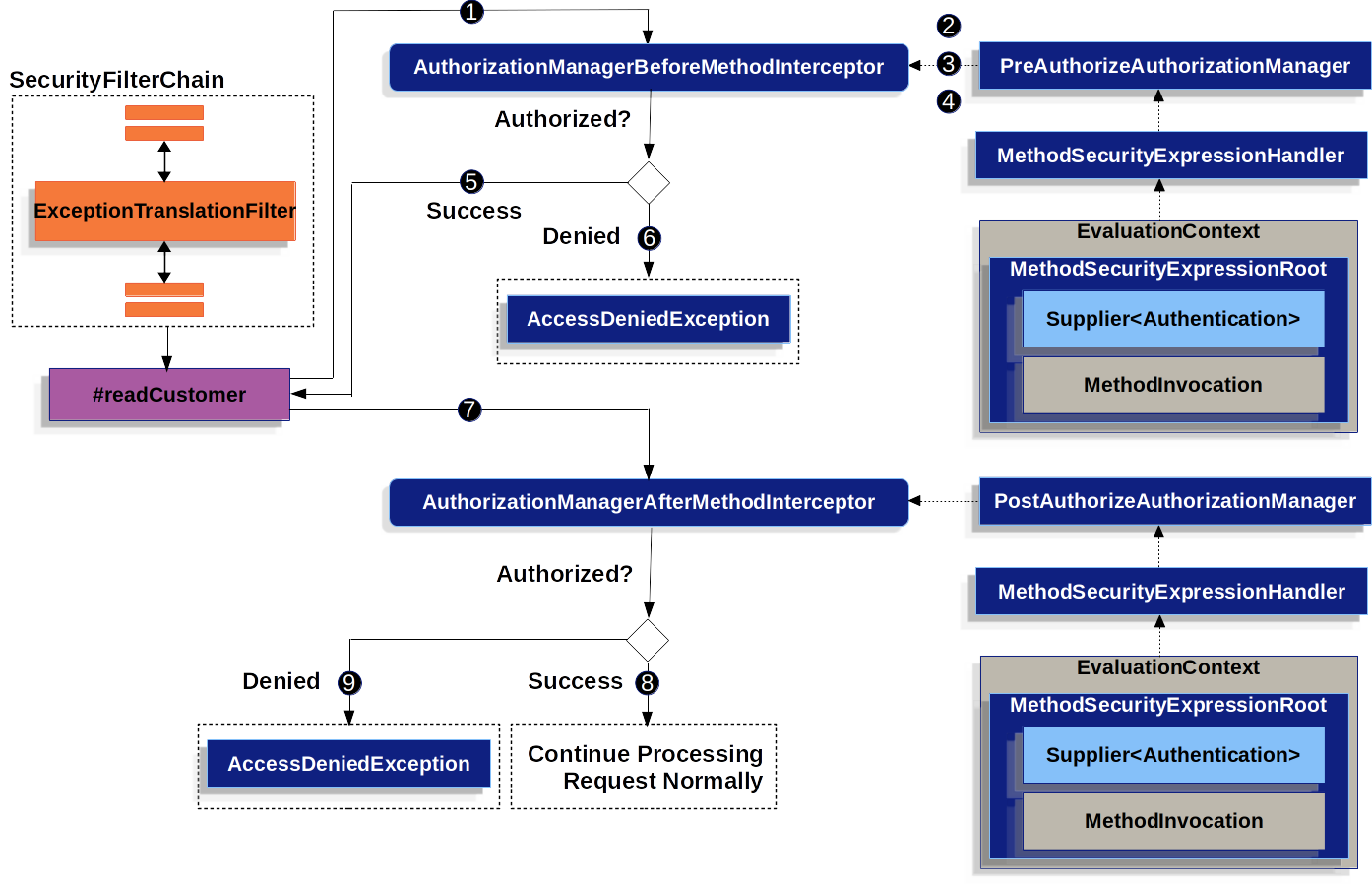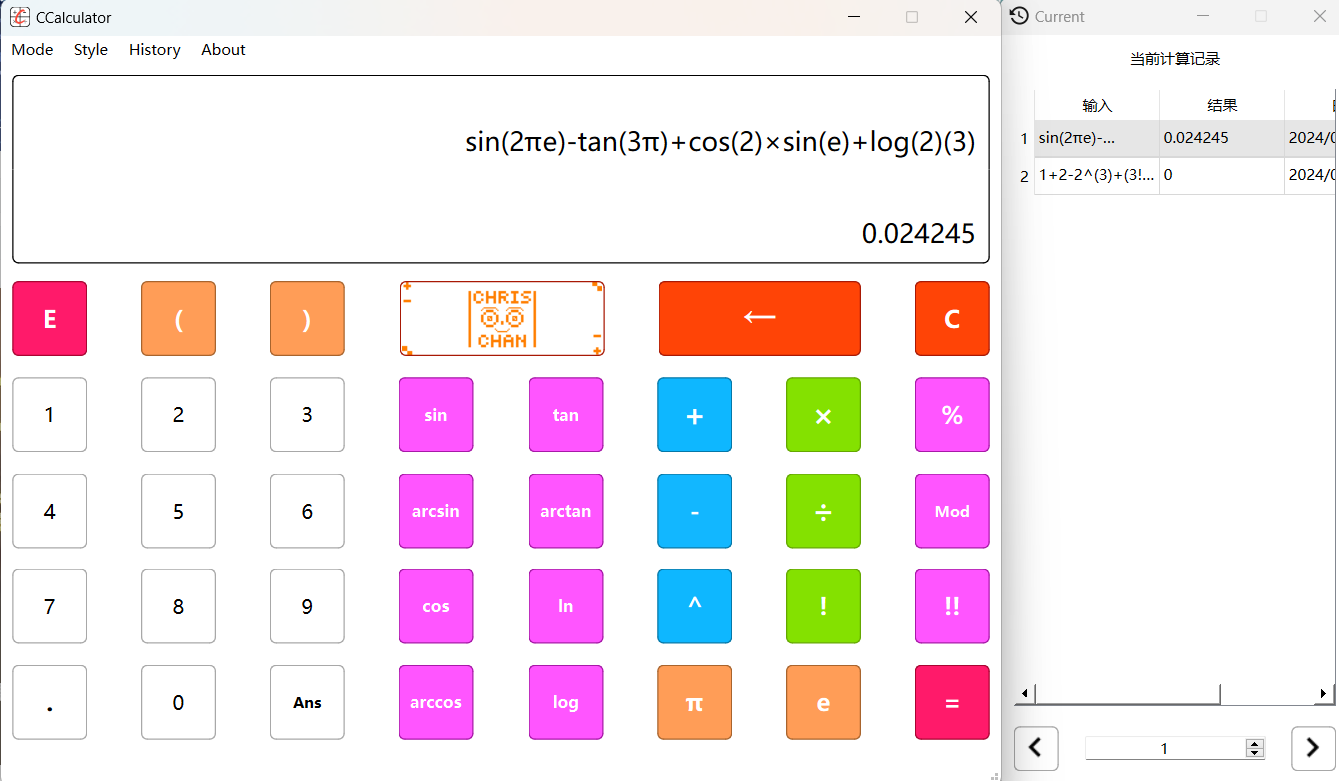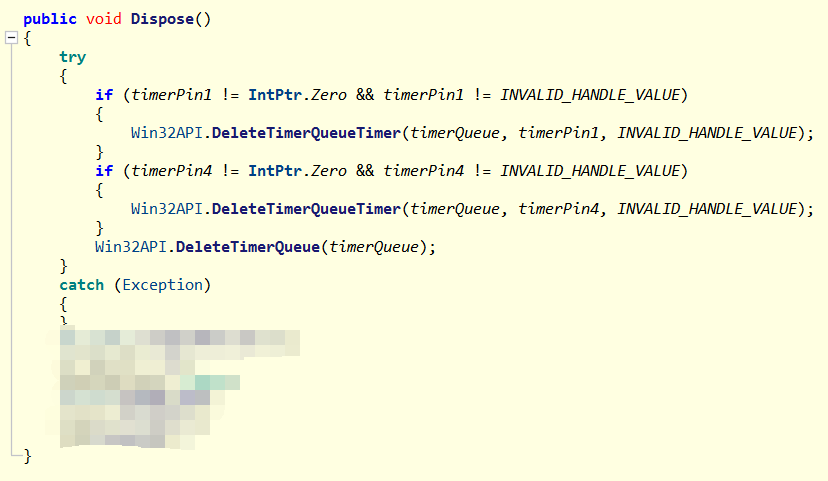Method Security
除了在请求级别进行建模授权之外,Spring Security 还支持在方法级别进行建模。
您可以在应用程序中激活它,方法是使用@EnableMethodSecurity 注释任何@Configuration 类,或者将 < method-security > 添加到任何 XML 配置文件中,如下所示:
@EnableMethodSecurity
然后,您可以立即使用@PreAuthorize、@PostAuthorize、@PreFilter 和@PostFilter 对任何 Spring 管理的类或方法进行注释,以授权方法调用,包括输入参数和返回值。
SpringBootStarterSecurity 默认情况下不激活方法级授权。
Method Security 还支持许多其他用例,包括 AspectJ 支持、自定义注释和几个配置点。考虑学习以下用例:
- Migrating from
@EnableGlobalMethodSecurity - Understanding how method security works and reasons to use it
- Comparing request-level and method-level authorization
- Authorizing methods with
@PreAuthorizeand@PostAuthorize - Providing fallback values when authorization is denied
- Filtering methods with
@PreFilterand@PostFilter - Authorizing methods with JSR-250 annotations
- Authorizing methods with AspectJ expressions
- Integrating with AspectJ byte-code weaving
- Coordinating with @Transactional and other AOP-based annotations
- Customizing SpEL expression handling
- Integrating with custom authorization systems
How Method Security Works
Spring Security 的方法授权支持在以下方面很方便:
- 提取细粒度授权逻辑;例如,当方法参数和返回值有助于授权决策时。
- 在服务层强制执行安全性
- 在风格上更倾向于基于注释而非基于HttpSecurity的配置
由于Method Security是使用Spring AOP构建的,因此您可以访问它的所有表达能力,以便根据需要覆盖Spring Security的默认值。
如前所述,首先将@EnableMethodSecurity 添加到@Configuration 类或者在 Spring XML 配置文件中添加 < sec: method-security/> 。
这个注释和 XML 元素分别取代了@EnableGlobalMethodSecurity 和 < sec: global-method-security/> :
- 使用简化的 AuthorizationManagerAPI 而不是元数据源、配置属性、决策管理器和选民。
- 支持直接基于 bean 的配置,而不需要扩展 GlobalMethodSecurityConfiguration 来定制 bean
- 使用原生 Spring AOP 构建,移除了抽象,并允许您使用 Spring AOP 构建块来定制
- 检查冲突注解,以确保明确的安全配置
- 符合 JSR-250
- 默认启用 @PreAuthorize、@PostAuthorize、@PreFilter 和 @PostFilter
如果您正在使用@EnableGlobalMethodSecurity 或 < global-method-security/> ,那么现在不推荐使用它们,并鼓励您进行迁移。
方法授权是 before- and after-method授权的组合。考虑一个服务 bean,它的注释方式如下:
@Service
public class MyCustomerService {
@PreAuthorize("hasAuthority('permission:read')")
@PostAuthorize("returnObject.owner == authentication.name")
public Customer readCustomer(String id) { ... }
}
当方法安全性被激活时,对 MyCustomerService # readCustomer 的给定调用可能类似于下面的内容:

- Spring AOP 调用了其代理方法 readCustomer。在代理的其他顾问中,它调用了匹配 @PreAuthorize 切入点的方法 AuthorizationManagerBeforeMethodInterceptor。
- 拦截器调用了 PreAuthorizeAuthorizationManager#check。
- 授权管理器使用 MethodSecurityExpressionHandler 来解析注解的 SpEL 表达式,并从包含 Supplier 和 MethodInvocation 的 MethodSecurityExpressionRoot 构建相应的 EvaluationContext。
- 拦截器使用这个上下文来评估表达式;具体来说,它从 Supplier 中读取 Authentication 并检查它是否有权限:read 在其权限集合中。
- 如果评估通过,那么 Spring AOP 继续调用方法。
- 如果没有,拦截器发布一个 AuthorizationDeniedEvent 并抛出一个 AccessDeniedException,ExceptionTranslationFilter 捕获并返回一个 403 状态码到响应。
- 方法返回后,Spring AOP 调用了匹配 @PostAuthorize 切入点的方法 AuthorizationManagerAfterMethodInterceptor,其操作与上述相同,但使用 PostAuthorizeAuthorizationManager。
- 如果评估通过(在这种情况下,返回值属于已登录的用户),则处理继续正常。
- 如果没有,拦截器发布一个 AuthorizationDeniedEvent 并抛出一个 AccessDeniedException,ExceptionTranslationFilter 捕获并返回一个 403 状态码到响应。
如果没有在 HTTP 请求的上下文中调用该方法,则可能需要自己处理 AccessDeniedException
Multiple Annotations Are Computed In Series
如上所述,如果一个方法调用涉及多个 Method Security 注释,则每个注释一次处理一个。这意味着它们可以被集体看作是“被捆绑在一起”的。换句话说,对于要授权的调用,所有的注释检查都需要通过授权。
Repeated Annotations Are Not Supported
也就是说,不支持在同一方法上重复相同的注释。例如,不能在同一个方法上放置@PreAuthorize 两次。
取而代之的是,使用 SpEL 的布尔支持或其对委托到单独 bean 的支持。
Each Annotation Has Its Own Pointcut
每个注释都有自己的切入点实例,它从方法及其封闭类开始,在整个对象层次结构中查找该注释或其元注释对应物。
您可以在 AuthorizationMethodPointcut 中看到这方面的详细信息。
Each Annotation Has Its Own Method Interceptor
每个注解都有其自己的专用方法拦截器。这样做的原因是使事情更具可组合性。例如,如果需要,您可以禁用 Spring Security 的默认行为,只发布 @PostAuthorize 方法拦截器。
方法拦截器如下:
- 对于 @PreAuthorize,Spring Security 使用 AuthorizationManagerBeforeMethodInterceptor#preAuthorize,进而使用 PreAuthorizeAuthorizationManager。
- 对于 @PostAuthorize,Spring Security 使用 AuthorizationManagerBeforeMethodInterceptor#postAuthorize,进而使用 PostAuthorizeAuthorizationManager。
- 对于 @PreFilter,Spring Security 使用 PreFilterAuthorizationMethodInterceptor。
- 对于 @PostFilter,Spring Security 使用 PostFilterAuthorizationMethodInterceptor。
- 对于 @Secured,Spring Security 使用 AuthorizationManagerBeforeMethodInterceptor#secured,进而使用 SecuredAuthorizationManager。
- 对于 JSR-250 注解,Spring Security 使用 AuthorizationManagerBeforeMethodInterceptor#jsr250,进而使用 Jsr250AuthorizationManager。
总的来说,您可以将以下列表视为添加 @EnableMethodSecurity 时 Spring Security 发布的拦截器的代表性示例。
@Bean
@Role(BeanDefinition.ROLE_INFRASTRUCTURE)
static Advisor preAuthorizeMethodInterceptor() {
return AuthorizationManagerBeforeMethodInterceptor.preAuthorize();
}
@Bean
@Role(BeanDefinition.ROLE_INFRASTRUCTURE)
static Advisor postAuthorizeMethodInterceptor() {
return AuthorizationManagerAfterMethodInterceptor.postAuthorize();
}
@Bean
@Role(BeanDefinition.ROLE_INFRASTRUCTURE)
static Advisor preFilterMethodInterceptor() {
return AuthorizationManagerBeforeMethodInterceptor.preFilter();
}
@Bean
@Role(BeanDefinition.ROLE_INFRASTRUCTURE)
static Advisor postFilterMethodInterceptor() {
return AuthorizationManagerAfterMethodInterceptor.postFilter();
}
在复杂的 SpEL 表达式上优先授权
通常,引入一个复杂的 SpEL 表达式是很诱人的,如下所示:
@PreAuthorize("hasAuthority('permission:read') || hasRole('ADMIN')")
然而,您可以将权限:read 授予具有 ROLE_ADMIN 角色的人。一种方法是通过 RoleHierarchy 实现:
@Bean
static RoleHierarchy roleHierarchy() {
return RoleHierarchyImpl.fromHierarchy("ROLE_ADMIN > permission:read");
}
然后在 MethodSecurityExpressionHandler 实例中设置它。这样你就可以得到一个更简单的@PreAuthorize 表达式,如下所示:
@PreAuthorize("hasAuthority('permission:read')")
或者,在可能的情况下,在登录时将特定于应用程序的授权逻辑改编为授予的权限。
Comparing Request-level vs Method-level Authorization
您应该何时选择方法级授权而不是请求级授权?这很大程度上取决于个人喜好;然而,考虑以下每种方式的优点列表,以帮助您做出决定。
| ** request-level** | request-level | method-level |
|---|---|---|
| authorization type | coarse-grained | fine-grained |
| configuration location | declared in a config class | local to method declaration |
| configuration style | DSL | Annotations |
| authorization definitions | programmatic | SpEL |
主要的折衷似乎是您希望授权规则存在于何处。
Authorizing with Annotations
Spring Security 支持方法级授权的主要方式是通过可以添加到方法、类和接口的注释。
Authorizing Method Invocation with @PreAuthorize
当 Method Security 处于活动状态时,可以使用@PreAuthorize 注释对方法进行注释,如下所示:
@Component
public class BankService {
@PreAuthorize("hasRole('ADMIN')")
public Account readAccount(Long id) {
// ... is only invoked if the `Authentication` has the `ROLE_ADMIN` authority
}
}
这意味着只有当提供的表达式 hasRole (‘ ADMIN’)通过时才能调用该方法。
然后,您可以测试该类,以确认它正在执行授权规则,如下所示:
@Autowired
BankService bankService;
@WithMockUser(roles="ADMIN")
@Test
void readAccountWithAdminRoleThenInvokes() {
Account account = this.bankService.readAccount("12345678");
// ... assertions
}
@WithMockUser(roles="WRONG")
@Test
void readAccountWithWrongRoleThenAccessDenied() {
assertThatExceptionOfType(AccessDeniedException.class).isThrownBy(
() -> this.bankService.readAccount("12345678"));
}
虽然@PreAuthorize 对于声明所需的权限非常有帮助,但是它也可以用来计算涉及方法参数的更复杂的表达式。
Authorization Method Results with @PostAuthorize
当 Method Security 处于活动状态时,可以使用@PostAuthorize 注释对方法进行注释,如下所示:
@Component
public class BankService {
@PostAuthorize("returnObject.owner == authentication.name")
public Account readAccount(Long id) {
// ... is only returned if the `Account` belongs to the logged in user
}
}
这意味着该方法只能在所提供的表达式 returObject.owner = = authentication.name 通过时才能返回值。ReturObject 表示要返回的 Account 对象。
然后,您可以测试该类,以确认它正在执行授权规则:
@Autowired
BankService bankService;
@WithMockUser(username="owner")
@Test
void readAccountWhenOwnedThenReturns() {
Account account = this.bankService.readAccount("12345678");
// ... assertions
}
@WithMockUser(username="wrong")
@Test
void readAccountWhenNotOwnedThenAccessDenied() {
assertThatExceptionOfType(AccessDeniedException.class).isThrownBy(
() -> this.bankService.readAccount("12345678"));
}
@ PostAuthorize 也可以是一个元注释,在类或接口级别定义,并使用 SpEL Authorization Expressions。
@ PostAuthorize 在防御不安全的直接对象引用时特别有用。事实上,它可以定义为如下元注释:
@Target({ ElementType.METHOD, ElementType.TYPE })
@Retention(RetentionPolicy.RUNTIME)
@PostAuthorize("returnObject.owner == authentication.name")
public @interface RequireOwnership {}
允许您以下列方式对服务进行注释:
@Component
public class BankService {
@RequireOwnership
public Account readAccount(Long id) {
// ... is only returned if the `Account` belongs to the logged in user
}
}
结果是,上述方法只有在其所有者属性与登录用户的名称匹配时才返回 Account。如果没有,SpringSecurity 将抛出 AccessDeniedException 并返回403状态代码。
Filtering Method Parameters with @PreFilter
当 Method Security 处于活动状态时,可以使用@PreFilter 注释对方法进行注释,如下所示:
@Component
public class BankService {
@PreFilter("filterObject.owner == authentication.name")
public Collection<Account> updateAccounts(Account... accounts) {
// ... `accounts` will only contain the accounts owned by the logged-in user
return updated;
}
}
这意味着从表达式 filterObject.owner = = authentication.name 失败的帐户中过滤出任何值。FilterObject 表示帐户中的每个帐户,用于测试每个帐户。
然后,您可以用以下方式测试该类,以确认它正在执行授权规则:
@Autowired
BankService bankService;
@WithMockUser(username="owner")
@Test
void updateAccountsWhenOwnedThenReturns() {
Account ownedBy = ...
Account notOwnedBy = ...
Collection<Account> updated = this.bankService.updateAccounts(ownedBy, notOwnedBy);
assertThat(updated).containsOnly(ownedBy);
}
@ PreFilter 支持数组、集合、映射和流(只要流仍然打开)。
例如,上面的 updateAccount 声明的功能与以下其他四个声明的功能相同:
@PreFilter("filterObject.owner == authentication.name")
public Collection<Account> updateAccounts(Account[] accounts)
@PreFilter("filterObject.owner == authentication.name")
public Collection<Account> updateAccounts(Collection<Account> accounts)
@PreFilter("filterObject.value.owner == authentication.name")
public Collection<Account> updateAccounts(Map<String, Account> accounts)
@PreFilter("filterObject.owner == authentication.name")
public Collection<Account> updateAccounts(Stream<Account> accounts)
结果是,上面的方法只有 Account 实例,其所有者属性与登录用户的名称匹配。
Filtering Method Results with @PostFilter
当 Method Security 处于活动状态时,可以使用@PostFilter 注释对方法进行注释,如下所示:
@Component
public class BankService {
@PostFilter("filterObject.owner == authentication.name")
public Collection<Account> readAccounts(String... ids) {
// ... the return value will be filtered to only contain the accounts owned by the logged-in user
return accounts;
}
}
这意味着从表达式 filterObject.owner = = authentication.name 失败的返回值中过滤掉任何值。FilterObject 表示帐户中的每个帐户,用于测试每个帐户。
然后,您可以像这样测试该类,以确认它正在执行授权规则:
@Autowired
BankService bankService;
@WithMockUser(username="owner")
@Test
void readAccountsWhenOwnedThenReturns() {
Collection<Account> accounts = this.bankService.updateAccounts("owner", "not-owner");
assertThat(accounts).hasSize(1);
assertThat(accounts.get(0).getOwner()).isEqualTo("owner");
}
@ PostFilter 支持数组、集合、映射和流(只要流仍然打开)。
例如,上面的 readAccount 声明的功能与以下其他三个声明的功能相同:
@PostFilter("filterObject.owner == authentication.name")
public Account[] readAccounts(String... ids)
@PostFilter("filterObject.value.owner == authentication.name")
public Map<String, Account> readAccounts(String... ids)
@PostFilter("filterObject.owner == authentication.name")
public Stream<Account> readAccounts(String... ids)
结果是,上面的方法将返回 Account 实例,其所有者属性与登录用户的名称匹配。
Authorizing Method Invocation with @Secured
@Secured 是授权调用的遗留选项。@PreAuthorize 取而代之,建议使用。
要使用@Secred 注释,您应该首先更改您的 Method Security 声明,以启用它,如下所示:
@EnableMethodSecurity(securedEnabled = true)
这将导致 Spring Security 发布相应的方法拦截器,该拦截器授权使用@Secure 注释的方法、类和接口。
Authorizing Method Invocation with JSR-250 Annotations
如果您希望使用 JSR-250注释,SpringSecurity 也支持这一点。@ PreAuthorize 具有更强的表达能力,因此推荐使用。
要使用 JSR-250注释,您应该首先更改您的 Method Security 声明,以便像下面这样启用它们:
@EnableMethodSecurity(jsr250Enabled = true)
这将导致 Spring Security 发布相应的方法拦截器,该拦截器授权使用@RolesAllows、@PermitAll 和@DenyAll 注释的方法、类和接口。
Declaring Annotations at the Class or Interface Level
它还支持在类和接口级别使用 Method Security 注释。
如果在类层面是这样的:
@Controller
@PreAuthorize("hasAuthority('ROLE_USER')")
public class MyController {
@GetMapping("/endpoint")
public String endpoint() { ... }
}
那么所有的方法都继承了类级别的行为。
或者,如果它在类和方法级别都像下面这样声明:
@Controller
@PreAuthorize("hasAuthority('ROLE_USER')")
public class MyController {
@GetMapping("/endpoint")
@PreAuthorize("hasAuthority('ROLE_ADMIN')")
public String endpoint() { ... }
}
然后,声明该注释的方法将覆盖类级注释。
对于接口也是如此,但是如果一个类从两个不同的接口继承了注释,那么启动就会失败。这是因为 SpringSecurity 无法判断您想要使用哪一个。
在这种情况下,可以通过向具体方法添加注释来解决歧义。
Using Meta Annotations
方法安全性支持元注释。这意味着您可以使用任何注释,并基于特定于应用程序的用例提高可读性。
例如,您可以将@PreAuthorize (“ hasRole (‘ ADMIN’)”)简化为@IsAdmin,如下所示:
@Target({ ElementType.METHOD, ElementType.TYPE })
@Retention(RetentionPolicy.RUNTIME)
@PreAuthorize("hasRole('ADMIN')")
public @interface IsAdmin {}
其结果是,在你的安全方法,你现在可以做以下代替:
@Component
public class BankService {
@IsAdmin
public Account readAccount(Long id) {
// ... is only returned if the `Account` belongs to the logged in user
}
}
这会产生更易读的方法定义。
Templating Meta-Annotation Expressions
您还可以选择使用元注释模板,它允许更强大的注释定义。
首先,发布以下 bean:
@Bean
static PrePostTemplateDefaults prePostTemplateDefaults() {
return new PrePostTemplateDefaults();
}
现在,您可以创建像@Hasrole 这样功能更强大的程序,而不是@IsAdmin,如下所示:
@Target({ ElementType.METHOD, ElementType.TYPE })
@Retention(RetentionPolicy.RUNTIME)
@PreAuthorize("hasRole('{value}')")
public @interface HasRole {
String value();
}
其结果是,在你的安全方法,你现在可以做以下代替:
@Component
public class BankService {
@HasRole("ADMIN")
public Account readAccount(Long id) {
// ... is only returned if the `Account` belongs to the logged in user
}
}
请注意,这也适用于方法变量和所有注释类型,但是您需要注意正确地处理引号,以便得到的 SpEL 表达式是正确的。
例如,考虑以下@HasAnyrole 注释:
@Target({ ElementType.METHOD, ElementType.TYPE })
@Retention(RetentionPolicy.RUNTIME)
@PreAuthorize("hasAnyRole({roles})")
public @interface HasAnyRole {
String[] roles();
}
在这种情况下,您将注意到不应该在表达式中使用引号,而应该在参数值中使用,如下所示:
@Component
public class BankService {
@HasAnyRole(roles = { "'USER'", "'ADMIN'" })
public Account readAccount(Long id) {
// ... is only returned if the `Account` belongs to the logged in user
}
}
这样,一旦替换,表达式就变成@PreAuthorize (“ hasAnyrole (‘ USER’,‘ ADMIN’)”)。
Enabling Certain Annotations
您可以关闭@EnableMethodSecurity 的预配置并将其替换为您自己的配置。如果要自定义 AuthorizationManager 或 Pointcut,可以选择这样做。或者您可能只想启用特定的注释,比如@PostAuthorize。
你可以这样做:
Only @PostAuthorize Configuration
@Configuration
@EnableMethodSecurity(prePostEnabled = false)
class MethodSecurityConfig {
@Bean
@Role(BeanDefinition.ROLE_INFRASTRUCTURE)
Advisor postAuthorize() {
return AuthorizationManagerAfterMethodInterceptor.postAuthorize();
}
}
上面的代码片段通过首先禁用 Method Security 的预配置,然后发布@PostAuthorize 拦截器本身来实现这一点。
Authorizing with <intercept-methods>
虽然使用 Spring Security 的基于注释的支持是方法安全的首选,但是您也可以使用 XML 来声明 bean 授权规则。
如果需要在 XML 配置中声明它,可以像下面这样使用 < 拦截方法 > :
<bean class="org.mycompany.MyController">
<intercept-methods>
<protect method="get*" access="hasAuthority('read')"/>
<protect method="*" access="hasAuthority('write')"/>
</intercept-methods>
</bean>
Authorizing Methods Programmatically
正如您已经看到的,有几种方法可以使用 Method Security SpEL 表达式指定非常重要的授权规则。
有许多方法可以让您的逻辑基于 Java 而不是基于 SpEL。这使得可以访问整个 Java 语言,从而提高可测试性和流控制。
Using a Custom Bean in SpEL
以编程方式授权方法的第一种方法是两步进程。
首先,声明一个 bean,该 bean 具有一个接受 MethodSecurityExpressionOperations 实例的方法,如下所示:
@Component("authz")
public class AuthorizationLogic {
public boolean decide(MethodSecurityExpressionOperations operations) {
// ... authorization logic
}
}
然后,按照以下方式在注释中引用该 bean:
@Controller
public class MyController {
@PreAuthorize("@authz.decide(#root)")
@GetMapping("/endpoint")
public String endpoint() {
// ...
}
}
SpringSecurity 将为每个方法调用调用该 bean 上的给定方法。
这样做的好处是,所有的授权逻辑都在一个单独的类中,可以独立进行单元测试和验证是否正确。它还可以访问完整的 Java 语言。
如果您想要包含更多关于决策性质的信息,您可以像下面这样返回一个自定义 AuthorizationDecision:
@Component("authz")
public class AuthorizationLogic {
public AuthorizationDecision decide(MethodSecurityExpressionOperations operations) {
// ... authorization logic
return new MyAuthorizationDecision(false, details);
}
}
或引发自定义 AuthorizationDeniedException 实例。但是请注意,最好是返回一个对象,因为这样不会产生生成堆栈跟踪的开销。
然后,您可以在自定义如何处理授权结果时访问自定义详细信息。
Using a Custom Authorization Manager
以编程方式授权方法的第二种方法是创建自定义 AuthorizationManager。
首先,声明一个授权管理器实例,比如:
@Component
public class MyAuthorizationManager implements AuthorizationManager<MethodInvocation>, AuthorizationManager<MethodInvocationResult> {
@Override
public AuthorizationDecision check(Supplier<Authentication> authentication, MethodInvocation invocation) {
// ... authorization logic
}
@Override
public AuthorizationDecision check(Supplier<Authentication> authentication, MethodInvocationResult invocation) {
// ... authorization logic
}
}
然后,使用切入点发布方法拦截器,该切入点对应于您希望 AuthorizationManager 运行的时间。例如,您可以将@PreAuthorize 和@PostAuthorize 的工作方式替换为:
@Configuration
@EnableMethodSecurity(prePostEnabled = false)
class MethodSecurityConfig {
@Bean
@Role(BeanDefinition.ROLE_INFRASTRUCTURE)
Advisor preAuthorize(MyAuthorizationManager manager) {
return AuthorizationManagerBeforeMethodInterceptor.preAuthorize(manager);
}
@Bean
@Role(BeanDefinition.ROLE_INFRASTRUCTURE)
Advisor postAuthorize(MyAuthorizationManager manager) {
return AuthorizationManagerAfterMethodInterceptor.postAuthorize(manager);
}
}
Customizing Expression Handling
或者,第三,您可以自定义如何处理每个 SpEL 表达式。为此,可以公开自定义 MethodSecurityExpressionHandler,如下所示:
Custom MethodSecurityExpressionHandler
@Bean
static MethodSecurityExpressionHandler methodSecurityExpressionHandler(RoleHierarchy roleHierarchy) {
DefaultMethodSecurityExpressionHandler handler = new DefaultMethodSecurityExpressionHandler();
handler.setRoleHierarchy(roleHierarchy);
return handler;
}
还可以继承 DefaultMessageSecurityExpressionHandler,以在默认值之外添加自己的自定义授权表达式。
Authorizing with AspectJ
Matching Methods with Custom Pointcuts
在 SpringAOP 上构建,您可以声明与注释无关的模式,类似于请求级授权。这具有集中方法级授权规则的潜在优势。
例如,您可以使用发布自己的 Advisor 或使用 < protected-pointcut > 将 AOP 表达式与服务层的授权规则匹配起来,如下所示:
import static org.springframework.security.authorization.AuthorityAuthorizationManager.hasRole
@Bean
@Role(BeanDefinition.ROLE_INFRASTRUCTURE)
static Advisor protectServicePointcut() {
AspectJExpressionPointcut pattern = new AspectJExpressionPointcut()
pattern.setExpression("execution(* com.mycompany.*Service.*(..))")
return new AuthorizationManagerBeforeMethodInterceptor(pattern, hasRole("USER"))
}
Integrate with AspectJ Byte-weaving
通过使用 AspectJ 将 Spring Security 通知编织到 bean 的字节代码中,有时可以提高性能。
在设置 AspectJ 之后,您可以非常简单地在@EnableMethodSecurity 注释或 < method-security > 元素中声明您正在使用 AspectJ:
@EnableMethodSecurity(mode=AdviceMode.ASPECTJ)
结果将是 Spring Security 将其advisors 作为 AspectJ 通知发布,以便它们可以相应地编入其中。
Specifying Order
如前所述,每个注释都有一个 Spring AOP 方法拦截器,并且每个注释都在 Spring AOP advisor 链中有一个位置。
也就是说,@PreFilter 方法拦截器的顺序是100,@PreAuthorize 的顺序是200,依此类推。
值得注意的是,还有其他基于 AOP 的注释,如@EnableTransactionManagement,其顺序为 Integer.MAX _ VALUE。换句话说,默认情况下,它们位于顾问链的末尾。
有时候,在 SpringSecurity 之前执行其他通知是很有价值的。例如,如果您有一个带有@Transactional 和@PostAuthorize 注释的方法,您可能希望在@PostAuthorize 运行时事务仍然处于打开状态,以便 AccessDeniedException 将导致回滚。
要让@EnableTransactionManagement 在方法授权通知运行之前打开事务,可以像下面这样设置@EnableTransactionManagement 的顺序:
@EnableTransactionManagement(order = 0)
由于最早的方法拦截器(@PreFilter)被设置为100的顺序,如果设置为零,则意味着事务通知将在所有 Spring Security 通知之前运行。
Expressing Authorization with SpEL
您已经看到了几个使用 SpEL 的示例,因此现在让我们更深入地介绍一下 API。
SpringSecurity 将其所有授权字段和方法封装在一组根对象中。最通用的根对象称为 SecurityExpressionRoot,它是 MethodSecurityExpressionRoot 的基础。当准备计算授权表达式时,SpringSecurity 将此根对象提供给 MethodSecurityevalationContext。
Using Authorization Expression Fields and Methods
它提供的第一件事是增强了 SpEL 表达式的授权字段和方法集。以下是最常用方法的简要概述:
- PermitAll-该方法不需要调用任何授权; 注意,在这种情况下,永远不会从会话检索 Authentication
- DenyAll-在任何情况下都不允许使用该方法; 请注意,在这种情况下,永远不会从会话检索 Authentication
- HasAuthority ——该方法要求 Authentication 具有与给定值匹配的 GrantedAuthority
- HasRole-hasAuthority 的一个快捷方式,它将 ROLE _ 或其他配置为默认前缀的内容作为前缀
- HasAnyAuthority ——该方法要求 Authentication 具有与任何给定值匹配的 GrantedAuthority
- HasAnyrole-hasAnyAuthority 的一个快捷方式,它将 ROLE _ 或任何被配置为默认前缀的东西作为前缀
- HasPermission-一个连接到您的 Permisonevalator 实例的钩子,用于执行对象级授权
以下是一些最常见的领域:
- Authentication ——与此方法调用关联的 Authentication 实例
- principal-与此方法调用相关联的 Authentication # getPrincipal
现在已经了解了模式、规则以及如何将它们配对在一起,您应该能够理解在这个更复杂的示例中发生了什么:
@Component
public class MyService {
@PreAuthorize("denyAll")
MyResource myDeprecatedMethod(...);
@PreAuthorize("hasRole('ADMIN')")
MyResource writeResource(...)
@PreAuthorize("hasAuthority('db') and hasRole('ADMIN')")
MyResource deleteResource(...)
@PreAuthorize("principal.claims['aud'] == 'my-audience'")
MyResource readResource(...);
@PreAuthorize("@authz.check(authentication, #root)")
MyResource shareResource(...);
}
- 由于任何原因,任何人都不能调用此方法
- 此方法只能由授予 ROLE _ ADMIN 权限的身份验证调用
- 此方法只能由授予 db 和 ROLE _ ADMIN 权限的身份验证调用
- 此方法只能由具有等于 “my-audience” 的 aud 声明的主体调用。
- 此方法只能在 bean authz 的检查方法返回 true 时调用。
Using Method Parameters
SpringSecurity 还支持包装任何注释了其方法安全性注释的对象。
实现这一点的最简单方法是使用@AuthorizeReturnObject 注释标记任何返回您希望授权的对象的方法。
例如,考虑以下 User 类:
public class User {
private String name;
private String email;
public User(String name, String email) {
this.name = name;
this.email = email;
}
public String getName() {
return this.name;
}
@PreAuthorize("hasAuthority('user:read')")
public String getEmail() {
return this.email;
}
}
给定一个像这样的界面:
public class UserRepository {
@AuthorizeReturnObject
Optional<User> findByName(String name) {
// ...
}
}
然后,从 findById 返回的任何 User 都将像其他 Spring Security 保护的组件一样受到保护:
@Autowired
UserRepository users;
@Test
void getEmailWhenProxiedThenAuthorizes() {
Optional<User> securedUser = users.findByName("name");
assertThatExceptionOfType(AccessDeniedException.class).isThrownBy(() -> securedUser.get().getEmail());
}
Using @AuthorizeReturnObject at the class level
@AuthorizeReturnObject可以放置在类级别。但是请注意,这意味着 Spring Security 将尝试代理任何返回对象,包括 String、 Integer 和其他类型。这通常不是你想要做的.
如果您希望对方法返回值类型(如 int、 String、 Double 或这些类型的集合)的类或接口使用@AuthorizeReturnObject,那么您还应该发布适当的 AuthorizationAdvisorProxyFactory。目标访问者如下:
@Bean
static Customizer<AuthorizationAdvisorProxyFactory> skipValueTypes() {
return (factory) -> factory.setTargetVisitor(TargetVisitor.defaultsSkipValueTypes());
}
Programmatically Proxying
还可以通过编程方式代理给定对象。
为此,您可以自动连接提供的 AuthorizationProxyFactory 实例,该实例基于您配置的方法安全拦截器。如果您使用的是@EnableMethodSecurity,那么这意味着它默认拥有@PreAuthorize、@PostAuthorize、@PreFilter 和@PostFilter 的拦截器。
您可以通过以下方式代理用户的实例:
@Autowired
AuthorizationProxyFactory proxyFactory;
@Test
void getEmailWhenProxiedThenAuthorizes() {
User user = new User("name", "email");
assertThat(user.getEmail()).isNotNull();
User securedUser = proxyFactory.proxy(user);
assertThatExceptionOfType(AccessDeniedException.class).isThrownBy(securedUser::getEmail);
}
Manual Construction
如果需要不同于 Spring Security 默认值的东西,还可以定义自己的实例。
例如,如果像下面这样定义 AuthorizationProxyFactory 实例:
import org.springframework.security.authorization.method.AuthorizationAdvisorProxyFactory.TargetVisitor;
import static org.springframework.security.authorization.method.AuthorizationManagerBeforeMethodInterceptor.preAuthorize;
// ...
AuthorizationProxyFactory proxyFactory = AuthorizationAdvisorProxyFactory.withDefaults();
// and if needing to skip value types
proxyFactory.setTargetVisitor(TargetVisitor.defaultsSkipValueTypes());
然后您可以将 User 的任何实例包装如下:
@Test
void getEmailWhenProxiedThenAuthorizes() {
AuthorizationProxyFactory proxyFactory = AuthorizationAdvisorProxyFactory.withDefaults();
User user = new User("name", "email");
assertThat(user.getEmail()).isNotNull();
User securedUser = proxyFactory.proxy(user);
assertThatExceptionOfType(AccessDeniedException.class).isThrownBy(securedUser::getEmail);
}
Proxying Collections
AuthorizationProxyFactory 通过代理元素类型和通过代理值类型映射来支持 Java 集合、流、数组、可选项和迭代器。
这意味着在代理 List 对象时,以下代码也可以工作:
@Test
void getEmailWhenProxiedThenAuthorizes() {
AuthorizationProxyFactory proxyFactory = AuthorizationAdvisorProxyFactory.withDefaults();
List<User> users = List.of(ada, albert, marie);
List<User> securedUsers = proxyFactory.proxy(users);
securedUsers.forEach((securedUser) ->
assertThatExceptionOfType(AccessDeniedException.class).isThrownBy(securedUser::getEmail));
}
Proxying Classes
在有限的情况下,代理 Class 本身可能是有价值的,AuthorizationProxyFactory 也支持这一点。这大致相当于在 Spring 框架中调用 ProxyFactory # getProxyClass 以支持创建代理。
当您需要提前构造代理类(如 SpringAOT)时,这种方法非常方便。
Support for All Method Security Annotations
AuthorizationProxyFactory 支持应用程序中启用的任何方法安全注释。它基于作为 bean 发布的 AuthorizationAdvisor 类。
因为@EnableMethodSecurity 默认发布@PreAuthorize、@PostAuthorize、@PreFilter 和@PostFilter 顾问,所以通常不需要做任何事情来激活该能力。
Custom Advice
如果您有也希望应用的安全性建议,您可以像下面这样发布您自己的 AuthorizationAdvisor:
@EnableMethodSecurity
class SecurityConfig {
@Bean
static AuthorizationAdvisor myAuthorizationAdvisor() {
return new AuthorizationAdvisor();
}
}
Spring Security 将把该顾问添加到 AuthorizationProxyFactory 在代理对象时添加的通知集中。
Working with Jackson
这个特性的一个强大用途是从控制器返回一个安全值,如下所示:
@RestController
public class UserController {
@Autowired
AuthorizationProxyFactory proxyFactory;
@GetMapping
User currentUser(@AuthenticationPrincipal User user) {
return this.proxyFactory.proxy(user);
}
}
但是,如果您正在使用 Jackson,这可能会导致一个序列化错误,如下所示:
com.fasterxml.jackson.databind.exc.InvalidDefinitionException: Direct self-reference leading to cycle
这是由于 Jackson 使用 CGLIB 代理的方式。为了解决这个问题,在 User 类的顶部添加以下注释:
@JsonSerialize(as = User.class)
public class User {
}
最后,您需要发布一个自定义拦截器来捕获为每个字段抛出的 AccessDeniedException,您可以这样做:
@Component
public class AccessDeniedExceptionInterceptor implements AuthorizationAdvisor {
private final AuthorizationAdvisor advisor = AuthorizationManagerBeforeMethodInterceptor.preAuthorize();
@Override
public Object invoke(MethodInvocation invocation) throws Throwable {
try {
return invocation.proceed();
} catch (AccessDeniedException ex) {
return null;
}
}
@Override
public Pointcut getPointcut() {
return this.advisor.getPointcut();
}
@Override
public Advice getAdvice() {
return this;
}
@Override
public int getOrder() {
return this.advisor.getOrder() - 1;
}
}
然后,您将看到一个不同的基于用户授权级别的 JSON 序列化。如果他们没有user:read权限,那么他们会看到:
{
"name" : "name",
"email" : null
}
如果他们真的有这个权限,他们会看到:
{
"name" : "name",
"email" : "email"
}
Providing Fallback Values When Authorization is Denied
在某些情况下,您可能不希望在没有所需权限的情况下调用方法时引发 AuthorizationDeniedException。相反,您可能希望返回一个后处理的结果,比如一个被屏蔽的结果,或者在调用方法之前拒绝授权的情况下返回一个默认值。
Spring Security 通过使用@HandleAuthorizationDenied 支持处理在方法调用时被拒绝的授权。该处理程序适用于在@PreAuthorize 和@PostAuthorize 注释中发生的被拒绝的授权,以及从方法调用本身抛出的 AuthorizationDeniedException。
让我们考虑一下上一节的例子,但是我们不创建 AccessDeniedExceptionInterceptor 来将 AccessDeniedException 转换为 null 返回值,而是使用@HandleAuthorizationDenied 的 handlerClass 属性:
public class NullMethodAuthorizationDeniedHandler implements MethodAuthorizationDeniedHandler {
@Override
public Object handleDeniedInvocation(MethodInvocation methodInvocation, AuthorizationResult authorizationResult) {
return null;
}
}
@Configuration
@EnableMethodSecurity
public class SecurityConfig {
@Bean
public NullMethodAuthorizationDeniedHandler nullMethodAuthorizationDeniedHandler() {
return new NullMethodAuthorizationDeniedHandler();
}
}
public class User {
// ...
@PreAuthorize(value = "hasAuthority('user:read')")
@HandleAuthorizationDenied(handlerClass = NullMethodAuthorizationDeniedHandler.class)
public String getEmail() {
return this.email;
}
}
- 创建返回空值的 MethodAuthorizationDeniedHandler 的实现
- 将 NullMethodAuthorizationDeniedHandler 注册为 bean
- 用@HandleAuthorizationDenied 注释该方法,并将 NullMethodAuthorizationDeniedHandler 传递给 handlerClass 属性
然后您可以验证返回的是 null 值而不是 AccessDeniedException:
您还可以使用@Component 注释类,而不用创建@Bean 方法
@Autowired
UserRepository users;
@Test
void getEmailWhenProxiedThenNullEmail() {
Optional<User> securedUser = users.findByName("name");
assertThat(securedUser.get().getEmail()).isNull();
}
Using the Denied Result From the Method Invocation
在某些情况下,您可能希望返回从被拒绝的结果派生的安全结果。例如,如果用户未被授权查看电子邮件地址,您可能希望对原始电子邮件地址应用一些屏蔽,即 useremail@example.com 将成为 use * * * *@example.com。
对于这些场景,可以重写 MethodAuthorizationDeniedHandler 中的 handleDeniedInvocationResult,该 Handler 将 MethodInvocationResult 作为参数。让我们继续前面的例子,但是不返回 null,我们将返回一个电子邮件的屏蔽值:
public class EmailMaskingMethodAuthorizationDeniedHandler implements MethodAuthorizationDeniedHandler {
@Override
public Object handleDeniedInvocation(MethodInvocation methodInvocation, AuthorizationResult authorizationResult) {
return "***";
}
@Override
public Object handleDeniedInvocationResult(MethodInvocationResult methodInvocationResult, AuthorizationResult authorizationResult) {
String email = (String) methodInvocationResult.getResult();
return email.replaceAll("(^[^@]{3}|(?!^)\\G)[^@]", "$1*");
}
}
@Configuration
@EnableMethodSecurity
public class SecurityConfig {
@Bean
public EmailMaskingMethodAuthorizationDeniedHandler emailMaskingMethodAuthorizationDeniedHandler() {
return new EmailMaskingMethodAuthorizationDeniedHandler();
}
}
public class User {
// ...
@PostAuthorize(value = "hasAuthority('user:read')")
@HandleAuthorizationDenied(handlerClass = EmailMaskingMethodAuthorizationDeniedHandler.class)
public String getEmail() {
return this.email;
}
}
- 创建 MethodAuthorizationDeniedHandler 的实现,该实现返回未授权结果值的屏蔽值
- 将 EmailMaskingMethodAuthorizationDeniedHandler 注册为 bean
- 用@HandleAuthorizationDenied 注释该方法,并将 EmailMaskingMethodAuthorizationDeniedHandler 传递给 handlerClass 属性
然后您可以验证是否返回了一封蒙蔽的电子邮件,而不是一个 AccessDeniedException:
@Autowired
UserRepository users;
@Test
void getEmailWhenProxiedThenMaskedEmail() {
Optional<User> securedUser = users.findByName("name");
// email is useremail@example.com
assertThat(securedUser.get().getEmail()).isEqualTo("use******@example.com");
}
在实现 MethodAuthorizationDeniedHandler 时,您可以选择返回的类型:
- 空值。
- 一个非空值,与方法的返回类型相关。
- 抛出异常,通常是 AuthorizationDeniedException 的实例。这是默认行为。
- 用于反应应用的 Mono 型。
注意,由于处理程序必须在应用程序上下文中注册为 bean,因此如果需要更复杂的逻辑,可以向它们注入依赖项。除此之外,您还可以使用 MethodInvation 或 MethodInvocationResult,以及 AuthorizationResult 获取与授权决策相关的更多细节。
Deciding What to Return Based on Available Parameters
考虑一个场景,不同的方法可能有多个掩码值,如果我们必须为每个方法创建一个处理程序,那么效率就会降低,尽管这样做完全没问题。在这种情况下,我们可以使用通过参数传递的信息来决定做什么。例如,我们可以创建一个自定义@Mask 注释和一个检测该注释的处理程序,以决定返回什么掩码值:
import org.springframework.core.annotation.AnnotationUtils;
@Target({ ElementType.METHOD, ElementType.TYPE })
@Retention(RetentionPolicy.RUNTIME)
public @interface Mask {
String value();
}
public class MaskAnnotationDeniedHandler implements MethodAuthorizationDeniedHandler {
@Override
public Object handleDeniedInvocation(MethodInvocation methodInvocation, AuthorizationResult authorizationResult) {
Mask mask = AnnotationUtils.getAnnotation(methodInvocation.getMethod(), Mask.class);
return mask.value();
}
}
@Configuration
@EnableMethodSecurity
public class SecurityConfig {
@Bean
public MaskAnnotationDeniedHandler maskAnnotationDeniedHandler() {
return new MaskAnnotationDeniedHandler();
}
}
@Component
public class MyService {
@PreAuthorize(value = "hasAuthority('user:read')")
@HandleAuthorizationDenied(handlerClass = MaskAnnotationDeniedHandler.class)
@Mask("***")
public String foo() {
return "foo";
}
@PreAuthorize(value = "hasAuthority('user:read')")
@HandleAuthorizationDenied(handlerClass = MaskAnnotationDeniedHandler.class)
@Mask("???")
public String bar() {
return "bar";
}
}
现在,拒绝访问时的返回值将根据@Mask 注释来决定:
@Autowired
MyService myService;
@Test
void fooWhenDeniedThenReturnStars() {
String value = this.myService.foo();
assertThat(value).isEqualTo("***");
}
@Test
void barWhenDeniedThenReturnQuestionMarks() {
String value = this.myService.foo();
assertThat(value).isEqualTo("???");
}
Combining with Meta Annotation Support
还可以将@HandleAuthorizationDenied 与其他注释组合起来,以减少和简化方法中的注释。让我们考虑一下上一节中的例子,并将@HandleAuthorizationDenied 与@Mask 合并:
@Target({ ElementType.METHOD, ElementType.TYPE })
@Retention(RetentionPolicy.RUNTIME)
@HandleAuthorizationDenied(handlerClass = MaskAnnotationDeniedHandler.class)
public @interface Mask {
String value();
}
@Mask("***")
public String myMethod() {
// ...
}
现在,当需要在方法中添加掩码行为时,您不必记得添加这两个注释。请务必阅读元注释支持部分了解更多关于用法的详细信息。
Migrating from @EnableGlobalMethodSecurity
如果使用@EnableGlobalMethodSecurity,则应该迁移到@EnableMethodSecurity。
Replace global method security with method security
如果使用@EnableGlobalMethodSecurity,则应该迁移到@EnableMethodSecurity。
Replace global method security with method security
@ EnableGlobalMethodSecurity 和 < global-method-security > 分别不推荐使用@EnableMethodSecurity 和 < method-security > 。默认情况下,新的注释和 XML 元素激活 Spring 的事后注释,并在内部使用 AuthorizationManager。
这意味着以下两个清单在功能上是等价的:
@EnableGlobalMethodSecurity(prePostEnabled = true)
@EnableMethodSecurity
对于不使用 pre-post注释的应用程序,请确保将其关闭,以避免激活不必要的行为。
例如:
@EnableGlobalMethodSecurity(securedEnabled = true)
应该改为:
@EnableMethodSecurity(securedEnabled = true, prePostEnabled = false)
Use a Custom @Bean instead of subclassing DefaultMethodSecurityExpressionHandler
作为性能优化,MethodSecurityExpressionHandler 引入了一个新方法,该方法采用 Supplier < Authentication > 而不是 Authentication。
这允许 Spring Security 延迟身份验证的查找,并且当您使用@EnableMethodSecurity 而不是@EnableGlobalMethodSecurity 时会自动利用这一点。
但是,假设您的代码扩展了 DefaultMethodSecurityExpressionHandler 并重写了 createSecurityExpressionRoot (Authentication,MethodInvation)以返回自定义的 SecurityExpressionRoot 实例。这将不再起作用,因为@EnableMethodSecurity 设置的安排改为调用 createevalationContext (Supplier < Authentication > ,MethodInvocation)。
令人高兴的是,这种级别的定制通常是不必要的。相反,您可以使用所需的授权方法创建自定义 bean。
或者,假设您想要一个@PostAuthorize (“ hasAuthority (‘ ADMIN’)”)的自定义计算。你可以创建一个像这样的自定义@Bean:
class MyAuthorizer {
boolean isAdmin(MethodSecurityExpressionOperations root) {
boolean decision = root.hasAuthority("ADMIN");
// custom work ...
return decision;
}
}
然后在注释中引用如下:
@PreAuthorize("@authz.isAdmin(#root)")
I’d still prefer to subclass DefaultMethodSecurityExpressionHandler我仍然希望继承 DefaultMethodSecurityExpressionHandler 类
如果您必须继续子类化 DefaultMethodSecurityExpressionHandler,您仍然可以这样做:
@Component
class MyExpressionHandler extends DefaultMethodSecurityExpressionHandler {
@Override
public EvaluationContext createEvaluationContext(Supplier<Authentication> authentication, MethodInvocation mi) {
StandardEvaluationContext context = (StandardEvaluationContext) super.createEvaluationContext(authentication, mi);
MethodSecurityExpressionOperations delegate = (MethodSecurityExpressionOperations) context.getRootObject().getValue();
MySecurityExpressionRoot root = new MySecurityExpressionRoot(delegate);
context.setRootObject(root);
return context;
}
}
Further Reading
现在您已经保护了应用程序的请求,如果您还没有保护它的请求,请保护它。您还可以进一步阅读关于测试应用程序或将 Spring Security 与应用程序的其他方面(如数据层或跟踪和度量)集成的内容。



















